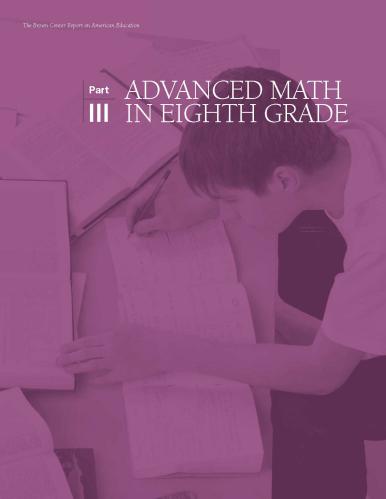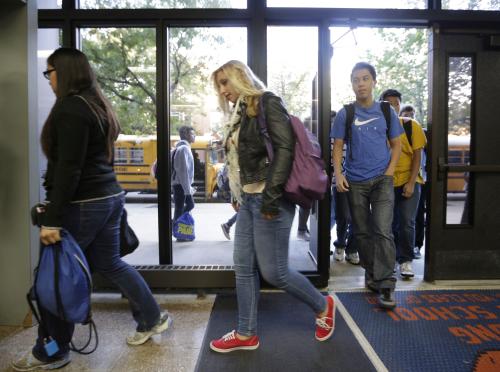STEM college graduates are predominantly white or Asian, a pattern that has persisted for years despite historically high black and Hispanic college attendance and completion rates. Could part of this gap be due to differentials in the rigor of coursework to which students are exposed as early as middle school?
Indeed, whether and how students are selected into advanced curricular tracks early in their schooling have real implications for their opportunities in high school and beyond. When courses are assigned through subjective systems based on teacher or counselor recommendations, inequitable access can result, with qualified black and Hispanic students less likely to be placed into advanced courses than their similarly qualified white counterparts.
We recently examined one district’s efforts to address this issue, and found that while a math course acceleration policy can meaningfully change the number and diversity of students entering the college preparation pipeline in middle and early high school, it may not be sufficient to enable these students to persist into advanced courses later in high school. This implies additional interventions may be necessary to stem leaks in the pipeline.
Nearly a decade ago, the leadership of the Wake County Public School System in North Carolina realized that too few of their students were enrolling in Advanced Placement calculus or other college preparatory math course work. Furthermore, students in these courses did not reflect the district’s demographic makeup. Those who did enroll in advanced math courses were disproportionately white or from higher-income households. These patterns generated deep concern, given the evidence that such courses can make substantial differences in students’ preparation for college—and for STEM majors in particular.
The Wake County leadership traced the root of the problem at least as far back as middle school, where students are formally sorted into math tracks for the first time. Middle school students set on the advanced math course trajectory would take algebra I in the seventh or eighth grade, while those on the non-advanced trajectory would take it in high school. Generally, students with later exposure to algebra I had a more difficult time completing the prerequisites to take calculus while in high school. Wake County thus decided to change its middle school course assignment system, with the explicit goal of increasing the number of students taking algebra I by eighth grade, given that this course is a critical gateway to college-preparatory math in high school.
Though some districts and states had previously adopted algebra-for-all policies, such programs have had the unintended effect of pushing too many students into coursework for which they were not sufficiently prepared. Wake County instead adopted a targeted strategy, using students’ prior standardized test scores to predict success in algebra I, as measured by the probability of passing North Carolina’s algebra I end-of-course exam. Middle schoolers predicted to have at least a 70 percent probability of success were recommended for “acceleration,” or placement into the advanced math course sequence. Under this policy, eligible sixth graders were recommended for advanced math, seventh graders for pre-algebra, and eighth graders for algebra I.
This new assignment rule had three immediate effects. First, the threshold the district chose implied that roughly three-fourths of students were recommended for acceleration, leading to a near doubling of enrollment in the accelerated course sequence. Second, the threshold prevented the least academically prepared students from being pushed too soon into coursework for which they were underprepared. Third, the new course assignment process was more objectively based on academic skill than it had previously been.
The district reasoned that this approach would accelerate students who otherwise might be overlooked as a result of variation in course grading practices and subjective beliefs. Indeed, our research on the short-run impacts of the new policy indicates that—conditional on a student’s academic skill—race, ethnicity, and income are less predictive of course assignment now than they once were. In fact, the new course placement rule led to substantial short-run reductions in socioeconomic and racial gaps in access to algebra I in the eighth grade.
While equitable access is important, we also investigated whether acceleration had long-term impacts on students’ course taking. We explore this question comparing the educational trajectories of students just above and below the eligibility threshold for acceleration. Such students are nearly identical in all ways except for the assignment to the accelerated coursework. As a result of this assignment policy, accelerated students were exposed to both a more advanced curriculum and a substantially higher-performing set of classroom peers.
Did their assignment make any difference once the students got to high school? Yes, though not always as the district might have predicted or hoped. Just one out of every seven students pushed into advanced middle school math classes persisted through 11th grade precalculus, suggesting the pipeline is leaky. Although the district clearly would have preferred a higher persistence rate, at the very least, the policy did increase the number of students on the college preparatory math track. The persistence rate did not vary by race, however, it did vary substantially by gender and income. One-third of female students persisted to precalculus, while few if any male students did. Over 40 percent of students from non-low-income families persisted to precalculus, while those from low-income families largely failed to do so. This difference in outcomes raises important questions about the nature of and access to supports that contribute to students’ ability to succeed given newly challenging curricula.
Also intriguing is the impact of math acceleration on college intentions. Those pushed into accelerated math courses were 20 percentage points more likely to describe themselves in 10th grade as intending to enroll in a four-year college, even after many had already left the accelerated track. This effect is consistent across student subgroups and may have been driven by a combination of exposure to more rigorous curricula and to more academically skilled peers who are likely to hold college aspirations.
We derive three primary lessons from this work. First, using objective measures of skill and readiness for course placement can help to identify qualified students that a discretionary system might overlook. Second, targeted math acceleration may be a more successful strategy for opening the gates to college-preparatory math compared to universal strategies that advance students regardless of readiness. Finally, despite the positive effects that we observe, middle school advancement without subsequent supports may be insufficient for improvements across all subgroups of students. We estimate that one-third of remaining accelerated students return to the non-accelerated track each year, meaning that the initial impact of acceleration on coursework decays over time. This leaky pipeline is consistent with evidence from California’s eighth grade algebra push and from other North Carolina districts. Access alone to early algebra may not be sufficient to ensure equitable participation in advanced courses.
Why the pipeline leaks remains a key question. Indeed, the door remains open for both intervention and evidence on efforts to retain more of those students who showed promise early on.








Commentary
Does more rigorous middle school math coursework change students’ college readiness?
April 27, 2017